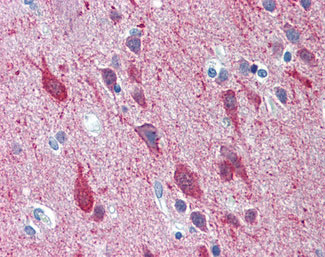KCNC2 / Kv3.2 Antibody (aa589-638)
Rabbit Polyclonal Antibody
- SPECIFICATION
- CITATIONS
- PROTOCOLS
- BACKGROUND

Application
| WB, IHC-P, E |
|---|---|
| Primary Accession | Q96PR1 |
| Reactivity | Human, Mouse, Rat |
| Host | Rabbit |
| Clonality | Polyclonal |
| Calculated MW | 70kDa |
| Dilution | ELISA (1:10000), IHC-P (5 µg/ml), WB (1:500-1:1000) |
| Gene ID | 3747 |
|---|---|
| Other Names | Potassium voltage-gated channel subfamily C member 2, Voltage-gated potassium channel Kv3.2, KCNC2 |
| Target/Specificity | Potassium Channel Kv3.2b Antibody detects endogenous levels of total Potassium Channel Kv3.2b protein. |
| Reconstitution & Storage | Store at -20°C. |
| Precautions | KCNC2 / Kv3.2 Antibody (aa589-638) is for research use only and not for use in diagnostic or therapeutic procedures. |
| Name | KCNC2 (HGNC:6234) |
|---|---|
| Function | Voltage-gated potassium channel that mediates transmembrane potassium transport in excitable membranes, primarily in the brain. Contributes to the regulation of the fast action potential repolarization and in sustained high-frequency firing in neurons of the central nervous system. Homotetramer channels mediate delayed-rectifier voltage-dependent potassium currents that activate rapidly at high- threshold voltages and inactivate slowly. Forms tetrameric channels through which potassium ions pass in accordance with their electrochemical gradient. The channel alternates between opened and closed conformations in response to the voltage difference across the membrane (PubMed:15709110). Can form functional homotetrameric and heterotetrameric channels that contain variable proportions of KCNC1, and possibly other family members as well; channel properties depend on the type of alpha subunits that are part of the channel. Channel properties may be modulated either by the association with ancillary subunits, such as KCNE1, KCNE2 or KCNE3 or indirectly by nitric oxide (NO) through a cGMP- and PKG-mediated signaling cascade, slowing channel activation and deactivation of delayed rectifier potassium channels (By similarity). Contributes to fire sustained trains of very brief action potentials at high frequency in retinal ganglion cells, thalamocortical and suprachiasmatic nucleus (SCN) neurons and in hippocampal and neocortical interneurons (PubMed:15709110). Sustained maximal action potential firing frequency in inhibitory hippocampal interneurons is negatively modulated by histamine H2 receptor activation in a cAMP- and protein kinase (PKA) phosphorylation- dependent manner. Plays a role in maintaining the fidelity of synaptic transmission in neocortical GABAergic interneurons by generating action potential (AP) repolarization at nerve terminals, thus reducing spike- evoked calcium influx and GABA neurotransmitter release. Required for long-range synchronization of gamma oscillations over distance in the neocortex. Contributes to the modulation of the circadian rhythm of spontaneous action potential firing in suprachiasmatic nucleus (SCN) neurons in a light-dependent manner (By similarity). |
| Cellular Location | Cell membrane; Multi-pass membrane protein. Membrane {ECO:0000250|UniProtKB:Q14B80}; Multi-pass membrane protein. Perikaryon {ECO:0000250|UniProtKB:Q14B80}. Cell projection, axon {ECO:0000250|UniProtKB:Q14B80}. Cell projection, dendrite {ECO:0000250|UniProtKB:Q14B80}. Postsynaptic cell membrane {ECO:0000250|UniProtKB:Q14B80}. Presynaptic cell membrane {ECO:0000250|UniProtKB:Q14B80}. Synapse, synaptosome {ECO:0000250|UniProtKB:P22462}. Synapse {ECO:0000250|UniProtKB:P22462} Apical cell membrane {ECO:0000250|UniProtKB:P22462}. Basolateral cell membrane {ECO:0000250|UniProtKB:P22462}. Note=Colocalizes with parvalbumin in globus pallidus neurons. Localizes in thalamocortical axons and synapses. Localizes on the surface of cell somata, proximal dendrites and axonal membranes. Also detected throughout the neuropil Localized in starburst cell somata and proximal dendrite processes Colocalized with GABA in presynaptic terminals. Clustered in patches in somatic and proximal dendritic membrane as well as in axons and presnypatic terminals of GABAergic interneurons; some of these patches are found near postsynaptic sites. {ECO:0000250|UniProtKB:P22462, ECO:0000250|UniProtKB:Q14B80} |
| Volume | 50 µl |

Thousands of laboratories across the world have published research that depended on the performance of antibodies from Abcepta to advance their research. Check out links to articles that cite our products in major peer-reviewed journals, organized by research category.
info@abcepta.com, and receive a free "I Love Antibodies" mug.
Provided below are standard protocols that you may find useful for product applications.
Background
Mediates the voltage-dependent potassium ion permeability of excitable membranes. Assuming opened or closed conformations in response to the voltage difference across the membrane, the protein forms a potassium-selective channel through which potassium ions may pass in accordance with their electrochemical gradient. Channel properties are modulated by subunit assembly (By similarity).
References
Haas M.,et al.Mamm. Genome 4:711-715(1993).
Isbrandt D.,et al.Submitted (JUN-2002) to the EMBL/GenBank/DDBJ databases.
Ota T.,et al.Nat. Genet. 36:40-45(2004).
Nakajima D.,et al.Submitted (MAR-2005) to the EMBL/GenBank/DDBJ databases.
Scherer S.E.,et al.Nature 440:346-351(2006).
If you have used an Abcepta product and would like to share how it has performed, please click on the "Submit Review" button and provide the requested information. Our staff will examine and post your review and contact you if needed.
If you have any additional inquiries please email technical services at tech@abcepta.com.













 Foundational characteristics of cancer include proliferation, angiogenesis, migration, evasion of apoptosis, and cellular immortality. Find key markers for these cellular processes and antibodies to detect them.
Foundational characteristics of cancer include proliferation, angiogenesis, migration, evasion of apoptosis, and cellular immortality. Find key markers for these cellular processes and antibodies to detect them. The SUMOplot™ Analysis Program predicts and scores sumoylation sites in your protein. SUMOylation is a post-translational modification involved in various cellular processes, such as nuclear-cytosolic transport, transcriptional regulation, apoptosis, protein stability, response to stress, and progression through the cell cycle.
The SUMOplot™ Analysis Program predicts and scores sumoylation sites in your protein. SUMOylation is a post-translational modification involved in various cellular processes, such as nuclear-cytosolic transport, transcriptional regulation, apoptosis, protein stability, response to stress, and progression through the cell cycle. The Autophagy Receptor Motif Plotter predicts and scores autophagy receptor binding sites in your protein. Identifying proteins connected to this pathway is critical to understanding the role of autophagy in physiological as well as pathological processes such as development, differentiation, neurodegenerative diseases, stress, infection, and cancer.
The Autophagy Receptor Motif Plotter predicts and scores autophagy receptor binding sites in your protein. Identifying proteins connected to this pathway is critical to understanding the role of autophagy in physiological as well as pathological processes such as development, differentiation, neurodegenerative diseases, stress, infection, and cancer.



